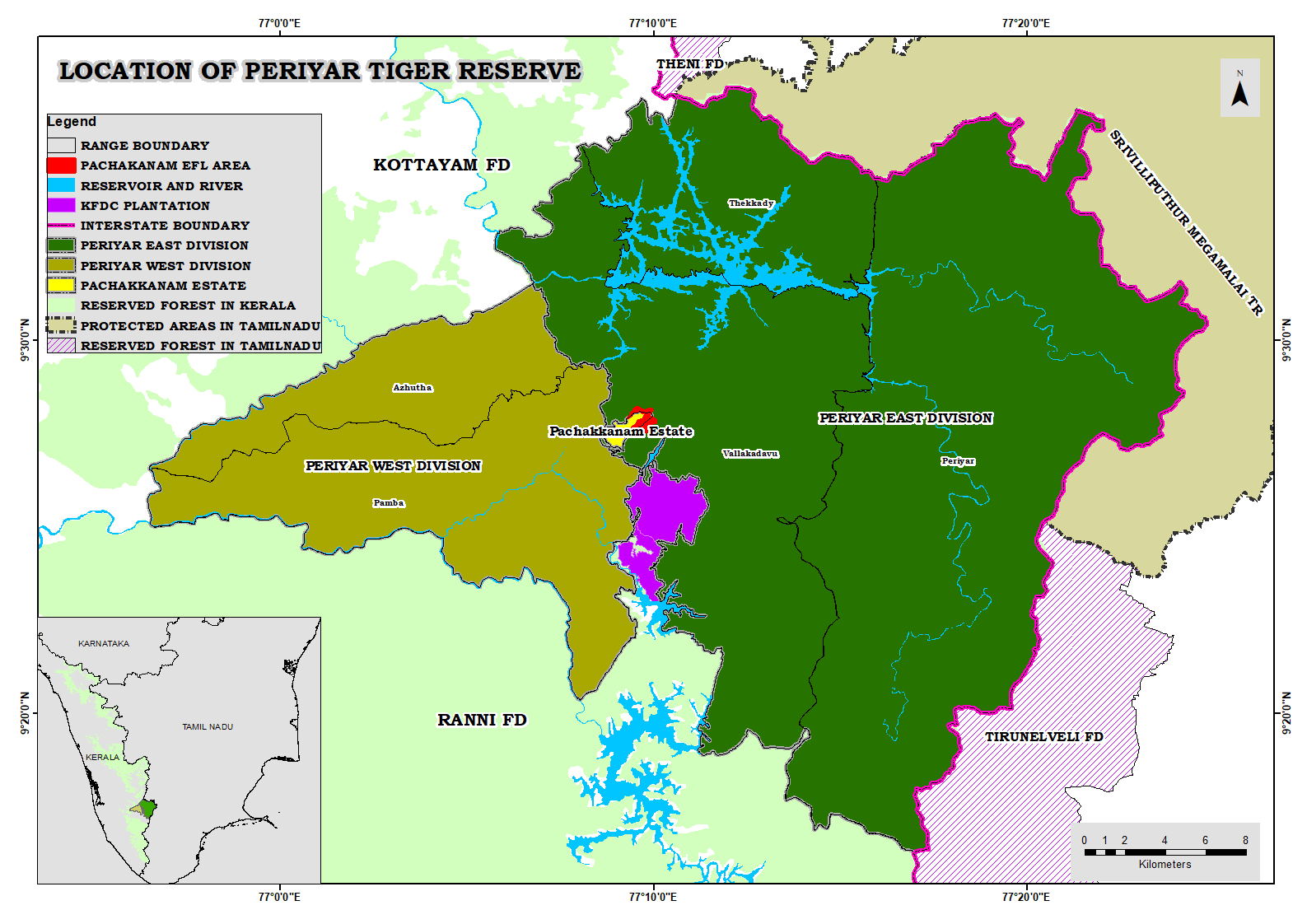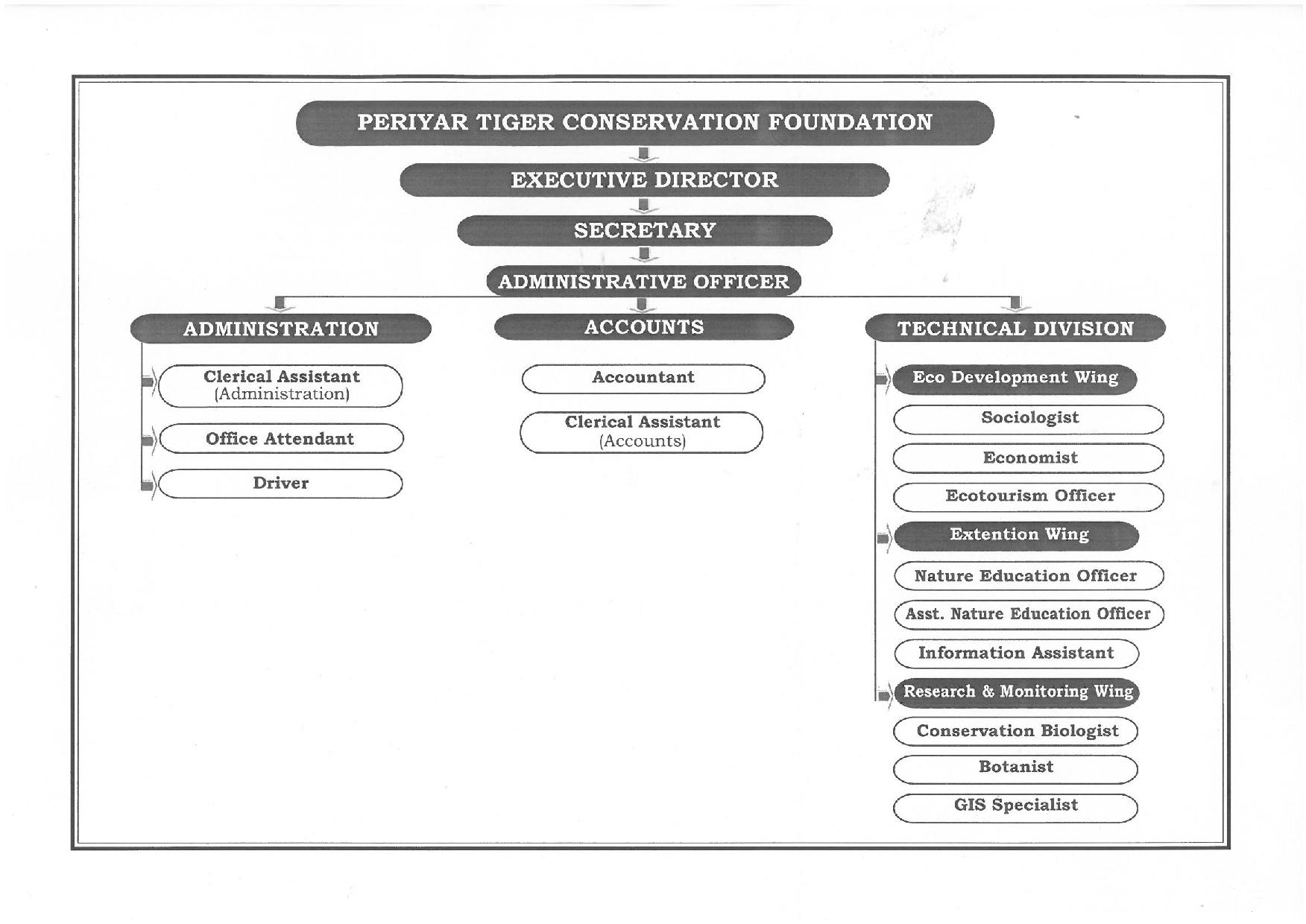PTR is situated in the Cardamom Hills and Pandalam Hills of the Southern Western Ghats between latitudes 9°35'30.14" and 9°19'28.11"N N and longitudes 77°11'45.48" and 77°17'4.84"E. The major portion of the Reserve forms the catchment of River Periyar and the rest is that of River Pamba. Administratively, PTR falls in Idukki, Kottayam and Pathanamthitta Districts of Kerala.

CLIMATE
Although the Tiger Reserve receives two monsoons, its distribution differs dramatically over the entire area. The highest recorded rainfall was 5803 mm at Pachakanam (2007), and lowest was 1145 mm at Thannikudy (2010). Roughly two-thirds of total rainfall occurs during the south-west monsoon between June and September. The North-East monsoon, though less predictable, normally occurs during October-December. It is the distribution and intensity of the North-East showers that has a major influence on management options. The wettest month is July and the driest January. Generally, the period from December to April is considered to be dry season. The temperature varies between 11°C and 27°C. Generally, April - May is the hottest and December – January is the coolest. Lowest humidity prevails during the dry months of February to April. The dew formation during December-January keeps the vegetation especially grass, green and wet. The wind velocity is at maximum with the onset of the South-West monsoon. The Reserve has two major rivers with their myriads of perennial feeder streams as well as reservoir. Water is available throughout the year and drought in the normal sense of the term may not occur. Severe drought was experienced during 1983 which resulted in extensive forest fires causing damages even to evergreen patches. Water sources many streams feeding the two major rivers viz. Periyar and Pamba are perennial. Unlike the streams in the evergreens above 1000m, some of the streams feeding Pamba and Azhutha dry up in peak summer. Except for a few, the marshes and streams on the grassy hill tops around the lake also dry up. The water level in lake fluctuates between a maximum of 41.5m (136 feet at the full reservoir level) to a minimum of 32m (104.9869 feet). A number of bunds, check dams and artificial pools have been made over the years, which hold water even during peak summer.
FOREST COVER
The extent of different land uses for core or critical tiger habitat and buffer are given below
Major part of core consists of evergreen and semi evergreen forests (Fig. 5.1) whereas buffer is primarily of moist deciduous forests .
Grassland-Savanna, an important feeding ground of prey species, occupies 22.4% of the Reserve. Eucalypt plantations (55 km2) are also present in core. Water spread area consists of 26 km2, of which 10 km2 is in core.
Phytoplankton flora of Periyar Lake
According to a preliminary study conducted on the phytoplankton flora of Periyar Lake (Krishnan, 2010), 59 taxa of Phytoplankton were identified from different representative samples. Among them, 54 were identified up to the species level and five were identified only up to genus level. Sixty percent of the total plankton identified include Diatoms, 30% Desmids and 10% Cyanophyceae. Among the benthic algae, 50% of the total comprised of Diatoms, 30% Cyanophyta and 20% Desmids. The epiphyte flora was abundant during the dry season. Diversity of algae is an indicator of natural aquatic system unaffected by pollution.
It was noted that during dry season, water concentrates due to decrease in water level with rich amounts of nutrients, especially Nitrogen and Phosphorus. This may lead to enriched growth of phytoplanktons during dry season and the flagellated forms as well as the filamentous forms flourish in the boat landing site of the lake, where the anthropogenic impact is high. All forms of plankton decrease during other seasons due to dilution and horizontal mixing of water. Increased cell size of the epiphytic phytoplankton may be due to availability of nutrients from the anthropogenic wastes as well as from the macrophytic plant body on which they colonize.
Flora of PTR
PTR, which forms about 10% of total forest area in the State, supports 41% (1985 species) of the Angiosperms (flowering plants) reported from Kerala (4801 species). A list of the flowering plants in PTR is given in Appendix 2.3. Out of the 1985 flowering plants, 519 species (about 26%) are endemic to southern WG and 149 species under various threat categories (Sasidharan, 1998). A list of the RET species is given in Appendix 2.4.
All the three species of Gymnosperms reported from Kerala are seen in PTR including the only indigenous conifer of South India, Nageia wallichiana. The other two are Cycus circinalis and Gnetum ula. About 150 species of pteridophytes are reported from the Reserve. Ophioglossum pendulum seen in the core areas of PTR is the first report from the Peninsular India. Among the flora listed from PTR, about 350 species are having identified medicinal properties.
Fauna, Habitats and Trophic Niches
The first scientific account on the fauna of Periyar Wildlife Sanctuary is available from the preliminary ecological survey conducted by Dr. G.U. Kurup of Zoological Survey of India in 1969. The first reconnaissance study of PTR was conducted by the Kerala Forest Research Institute during 1977-78 (Vijayan et al., 1979 and Vijayan, 1980) as part of the long-term study on the ecology of PTR with special reference to wildlife (Nair et al., 1985) funded by the Kerala Forest Department. This study brought out the first account of major mammalian species and a checklist of birds. During the past, there had been several studies on different groups of animals. Vertebrates are the most studied group. Among the invertebrates, only information available is an inventory of butterflies and spiders.
Mammals of PTR
A total of 66 species of mammals, under 50 genera and 25 families, are reported from PTR. This forms about 68% of the non-marine mammals reported from Kerala. Of the 66 species of mammals, 7 are endemic to Western Ghats (Table 2.5). The list of mammals in PTR is given in Appendix 2.5.
A brief description of selected mammals is given below.
Avifauna
PTR is one of the Important Bird Areas (IBA) in the country. Three hundred and twenty three taxa of birds have so far been recorded in PTR (Veeramani and Krishnan, 2002). The Reserve has a good representation of Southern Western Ghats endemics with thirteen species (Table 2.11). Twenty three species of aquatic birds were recorded in the lake area, out of which 17 are residents and 6 winter visitors. Large cormorants, which were absent earlier, are seen in large numbers while there is a decline in the number of darters. Low number of water birds is attributed to absence of shallow water bodies. There is also decrease in number of tree stumps due to decay. List of birds reported from PTR is given in Appendix 2.6.
There had been studies on raptors (Shrivastava et al.,1993), drongos (Vijayan., 1992) and barbets (Yahya., 2001). Robin and Sukumar (2002) reported White bellied short-wing at a height of 950 m from PTR. Veeramani et al. (2005) added 14 species to the existing list of birds of PTR. Robertson and Jackson (1992) and Elamon (2005) published Field Guides on Birds of Periyar.
Reptiles
Of the 172 species of reptiles reported from Kerala, 48 species under 33 genera and 12 families are recorded from PTR (Appendix 2.7). Among them, 17 are endemic to the Western Ghats (Table 2.12).
Amphibians
The amphibian diversity in Kerala is rich with 85 species. However, this group is not well documented in PTR. Twenty nine species in 17 genera and 9 families occur in the Reserve (Appendix 2.8). Of these, 12 species are endemic to the WG (Table 2.13).
Fishes
Periyar Lake and its associated streams support several interesting and important fishes (Arun et al., 1996; Zacharias et al., 1996; Zacharias and Minimol, 1999; Gopi, 2001). Some of them are Tor khudree (Sykes), Lepidopygopsis typus Raj, Travancoria jonesi Hora, Crossocheilus periyarensis (Menon and Jacob), Puntius ophicephalus (Raj) and Garra periyarensis Gop



© 2020 Periyar Tiger Conservation Foundation . All Rights Reserved . Designed by Saintgits College of Engineering